Continuing from our previous blog post on "Technologies Used with Brushless Motors," we'll now delve deeper into the efficiency aspect of brushless motors and compare them to AC motors.
According to the World Energy Outlook 2016 published by the IEA (International Energy Agency), more than half of the world's total power usage is motor-related. As a result, reducing energy consumption is a pressing global concern. The International Standard IEC 60034-30-1 has set efficiency classes for induction motors ranging from 120 W to 1,000 kW. Currently, efficiency classes up to IE4 have been established, but an IE5 efficiency class is anticipated, which is expected to reduce losses from an IE4 motor by 20%. You can refer to Figure 5.18 for more details.
Brushless motors equipped with built-in permanent magnets do not fall under IEC 60034-30-1, yet they are more efficient than three-phase AC induction motors. When combined with a drive circuit, the efficiency of a brushless motor surpasses even the anticipated IE5 efficiency class. We’ll now explore the loss reduction technology of brushless motors, focusing particularly on products from Oriental Motor's BMU Series.
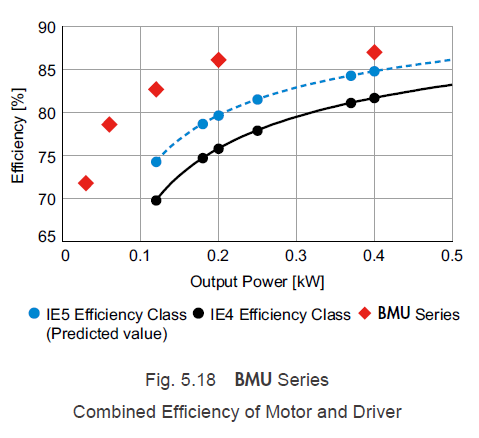
**5.5.1 Motor Loss**
The different types of motor loss are illustrated in Figure 5.19. Motor loss mainly consists of copper loss, iron loss, stray load loss, and mechanical loss. Generally, a significant portion of motor loss comes from copper loss and iron loss. Additionally, as the size of the motor decreases, the proportion of copper loss tends to increase. Therefore, it's crucial to implement effective countermeasures to reduce losses based on the motor's size.
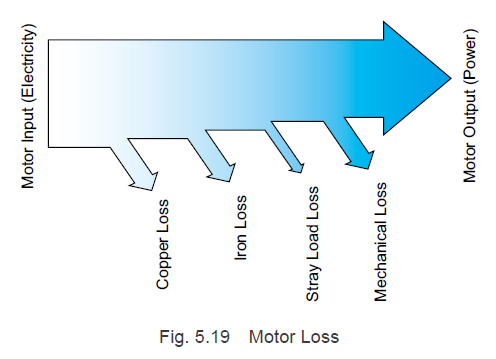
Let's now discuss the main types of loss and the associated technologies for reducing them.
**5.5.2 Copper Loss**
Copper loss refers to the joule loss caused by currents flowing through copper wires, and it can be calculated using the following formula:

As shown in Formula (5.4), copper loss decreases as the current value and winding resistance value become lower. Furthermore, Formula (5.5) indicates that the winding resistance value decreases as the conductor cross-sectional area increases, thus reducing copper loss. This highlights the importance of winding thick copper wires with a high space factor. The ratio of the slot cross-sectional area (the area of the stator with the copper wire windings) occupied by the copper wire is referred to as the space factor, and a higher value means less unused space among the copper wire windings.
**a. Reduction in the Current Value**
Induction motors generate torque when an induced current flows through the cage-type conductor inside the rotor due to the rotating magnetic field created by the stator. Consequently, winding currents include currents used to generate torque and currents used to create induced currents. Copper loss occurs in both the stator windings and the cage-type conductor due to these currents.
Since brushless motors employ permanent magnets in their rotors, induced currents are unnecessary. Only currents needed to generate torque are required, enabling a reduction in winding current compared to induction motors. This eliminates copper loss in the rotor and reduces copper loss in the stator windings, resulting in less copper loss overall than with induction motors.
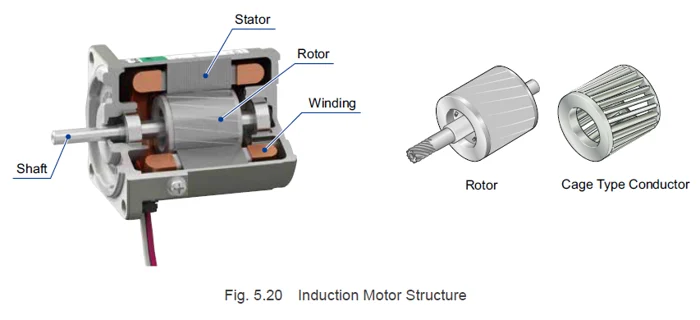
**b. Reduction in the Winding Resistance Value**
Brushless motors developed recently, including the BMU Series, utilize neodymium sintered magnets with six times the energy product of conventional neodymium bonded magnets. This has increased the magnetic flux density from the rotor magnets, allowing the number of coil turns to be reduced compared to conventional products with the same output power.
However, due to the increased magnetic flux density, the tooth width needs to be expanded, as shown in Figure 5.21. To address this, a frameless structure without a motor case is employed, and the external diameter of the stator iron core is increased, raising the slot area. Additionally, technology for improving wire alignment has been developed. These measures enable the use of thicker conductors, reducing winding resistance and copper loss.
Moreover, the increased magnetic flux density not only allows for fewer coil turns but also shortens the length of the stator core.
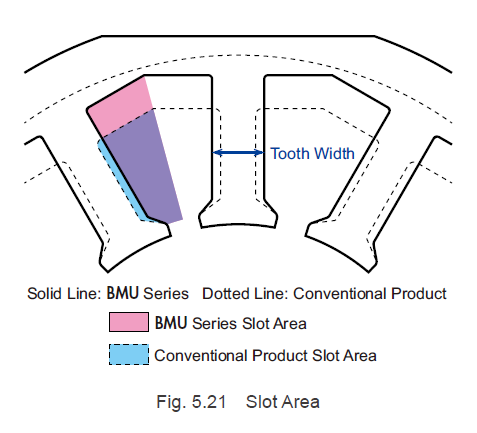
The BMU Series, through high-performance magnets and enhanced stator shape and winding techniques, achieves a stator core length that is half that of conventional products and reduces copper loss by 11%.
**5.5.3 Iron Loss**
Iron loss is divided into eddy current loss and hysteresis loss. Eddy current loss occurs within the core due to the time variation of the magnetic flux density and flows through the stator core and rotor core. Hysteresis loss occurs in magnetizing energy resulting from alternating magnetization. These are represented by the following formulas:
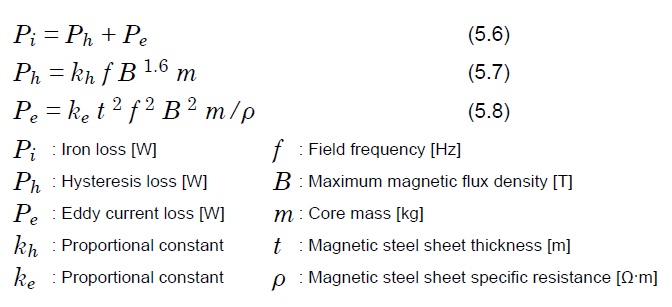
As shown by Formulas (5.7) and (5.8), the factors related to motor iron loss can be categorized as:
- Proportional constants and specific resistance, determined by the magnetic steel sheet material.
- The thickness of the magnetic steel sheet.
- Field frequency, maximum magnetic flux density, and core mass, determined by motor design.
To reduce iron loss in the motor, a magnetic steel sheet that is thin, has low iron loss, high saturation magnetic flux density, and good frequency dependence is ideal. However, each of these characteristics has trade-offs. Additionally, considering processability and cost, the choice of characteristics depends on the required motor properties. Regarding design-related elements, it is necessary to optimize the magnets used and the balance between copper loss and iron loss.
**TIP**: For more information on hysteresis loss and eddy current loss, please refer to Design World's article, "Hysteresis loss and eddy current loss: What’s the difference?" on Motion Control Tips.
The BMU Series and BLE2 Series next-generation brushless motors utilize high-performance magnets to halve the stator length compared to conventional motors, and combine this with high-performance magnetic steel sheets to **reduce iron loss by 50%**. Utilizing technologies like these enables the BMU Series to have a total length that is **12% shorter** than conventional products, with **33% higher output power** and **7% higher efficiency**.
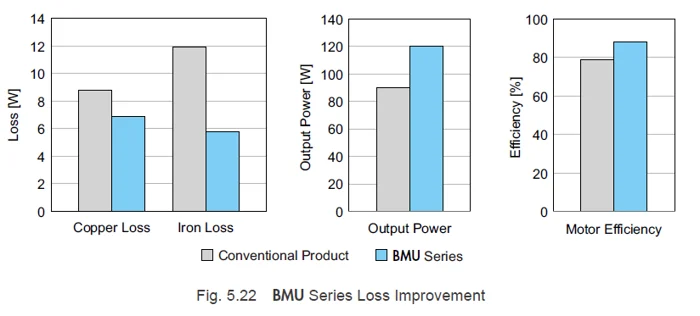
**5.5.4 Stray Load Loss**
The loss remaining after subtracting copper loss, iron loss, and mechanical loss from the total motor loss is the stray load loss. Traditionally, this was considered a loss with unclear causes. However, thanks to advancements in analysis technology in recent years, stray load loss has become visible as local loss due to leakage flux and similar phenomena.
**5.5.5 Mechanical Loss**
Mechanical loss in motors refers to friction loss from bearings, oil seals, and other mechanical contact areas. An example is the windage loss due to the types of cooling fans installed in most induction motors. With brushless motors, there is minimal loss, and internal cooling fans are not necessary, so mechanical loss can be minimized.
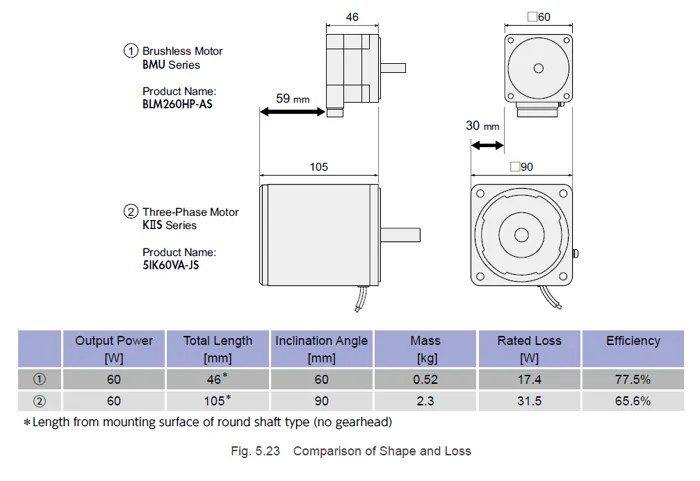
**5.6 Small and Lightweight Motors**
Brushless motors are smaller and lighter than three-phase AC motors while still offering the same rated output power. A motor's rated output power is the output power at which the temperature rise in the parts used (primarily the winding) satisfies the permissible temperature range when the motor is operated continuously under certain conditions determined by the specification, such as ambient temperature and supply voltage.
Due to the high efficiency and energy-saving technology explained in "5.5 High Efficiency, Energy Saving," brushless motors have minimal motor loss. The temperature rise in the motor balances loss with heat release, so the less loss there is, the smaller the motor can be.
A comparison of the shapes and loss amounts of a brushless motor and a three-phase AC motor with the same output power is shown in Figure 5.23.
Since the motor is small and lightweight, this results in the machine being smaller and lighter as well. In particular, with battery-driven vehicles, small size and lightness are emphasized because they are directly related to how long the vehicle can be driven.

Thank you for reaching the end of this Technical Manual Series. If you have any questions or would like to learn more, please consult with our team via live chat, phone, or email.


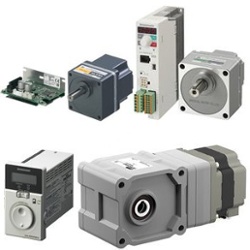
Subscribe (top right corner) to receive monthly updates!
Plastic 3D Printing,3D Printing Prototype,3D Printer Plastic,Professional 3D Printing Services
Ningbo Jiongke Technology Co., Ltd , https://www.processingmfg.com
